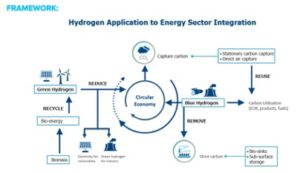By Alisson Pacheco Ramos, BA in Management & Finance at Audencia Business School
We are currently going through dramatically changing times. Among a series of sanitary, geopolitical, and environmental crises, our current globalised economy is facing a major shift compared to what was established so far. France and Europe have already undertaken efforts to achieve their newly set target of reaching carbon neutrality by 2050.
The challenges we face are unprecedented. The goal is to limit global warming to +1.5°C compared to the pre-industrial era – past this point, according to the IPCC, the climate would become too extreme for our human civilisation, increasing the risks of extreme droughts, flash floods, etc. According to the same source, limiting global warming to 1.5°C should be achievable, precisely by reaching “net zero” emissions by 2050. It is also backed up by the IEA, which has recently built a complete comprehensive global Roadmap that shows how governments should change the energy industry to achieve a net zero energy system by 2050, and how the benefits would far outweigh the drawbacks.
A Newly Found Form of Energy: Green Hydrogen
Among the solutions to reach carbon neutrality, one that comes up regularly is Green Hydrogen, also called low-carbon Hydrogen. As it names implies, it is a form of Hydrogen (a very lightweight gas) that either comes from “Green” energy sources or other, low-carbon emitting methods of producing Hydrogen. This type of Hydrogen is made from electricity, using wind turbines, photovoltaic panels, and other forms of renewable energy, through electrolysis, using water. However, it only represents 1% of global Hydrogen production today – the rest being high carbon-emitting methods, like chemically produced hydrogen using hydrocarbons.
The main advantage of this type of energy is that it is highly versatile, with a very high energy density compared to other forms of energy (such as methane or oil). It is also transportable and can easily be converted back into electricity using a fuel cell; it even can be used for heating buildings and industries if distributed into pipelines.
Green Hydrogen In a Circular Carbon Economy
This is where a specific type of circular economy can be put into place: a “circular carbon economy”. This has the advantage of being a decarbonised economy, where Green Hydrogen, as well as fuels derived from them, can replace fuels with higher carbon emissions in a wide range of sectors. What makes it key to a decarbonised economy is precisely its versatility: from low-carbon heating and feedstock to its usage to replace gas in chemical processes, it can also be used as an anchor for recycling CO2.
Here is an example of how Hydrogen can be integrated into the Energy Sector:

Source: 2020, International Energy Forum (IEF), “The Role of Hydrogen in Sustainable Growth”
Also, Green Hydrogen is key to the decarbonisation of the Energy Sector, as it could enable renewable electricity to increase its contribution to the power grid by building up a reliable supply (most notably through storage or fuel cells).
Mass-Production of Green Hydrogen: A Path Full of Challenges
There are, however, obstacles that we have yet to overcome for the wide-scale implementation of Green Hydrogen in our Economy: namely, its prohibitive cost, and the absence of appropriate infrastructure.
Standard costs for Green Hydrogen today are around 6 to 12$ per kilogram (compared to a goal of less than 2$/kg to be economically viable). Nevertheless, Green H2 could already be used today for transport, as this average cost of 6-12$/kg is already competitive compared to the current prices of oil (around 1.8€/L, according to the EU Commission, which would be equivalent to 19.8€/kg of H2, or 19.5$/kg).
Concerning infrastructure, it is a necessary investment to produce and distribute green hydrogen on a wide scale. Distribution and storage networks will have to be built, as well as electrolyser production systems, hydrogen pipelines and fuelling systems, and of course, an enormous quantity of zero-carbon power generation. The total investment would be as much as $10 trillion by 2070 to achieve the IEA +2°C temperature goal.
Finally, the last challenge we must face is political will: fortunately, on this matter, everything seems to be going in the right direction, most notably in France and other EU countries – though it is not the case in other countries around the world, particularly in Sub-Saharan Africa and South-Eastern Asia (excluding China), mostly due to the lack of financing or water scarcity. The IEA has shown how international action is the key to scaling up hydrogen production, with promising developments on renewables showing that through encouraging policies and technological innovation, it is possible to build a clean global industry. Besides, some regions around the world are prone to great potential in Green Hydrogen production, with again Sub-Saharan Africa, as well as Latin America potentially being on top.
The current trend for Green Hydrogen (mostly around Europe) is to be carried on, unlike the previous Hydrogen Hype Cycle (from 2002 to 2009) which resulted in a dead end. We must continue pushing for action against climate change, with our current increased awareness on the matter and the escalating prices of fossil fuels; we can now see how hydrogen is a key component of the energy transition around the world, provided we focus on producing and using it through low greenhouse-emitting means.

Alisson Pacheco Ramos
Alisson Pacheco Ramos is a Peruvian student pursuing a Master's degree in Management and finance at Audencia Business School in Nantes, France. She is passionate about Finance and Strategy Consulting. Her motivation for social innovation, responsible business, and sustainable development as a strategy drives her to always surpass herself and anticipate the future, transforming large-scale, high-impact businesses. Her ability to communicate effectively in multiple languages is a valuable asset, she combines her excellent analytical skills in financial services, network excellence, digital, and cost analysis with knowledge of Law, Accounting, digital marketing, and renewable energy to advocate for impactful solutions firmly rooted in scientific evidence, spanning Business, Markets, and Sustainable Finance.

I enjoy studying and I think this website got some genuinely useful stuff on it! .